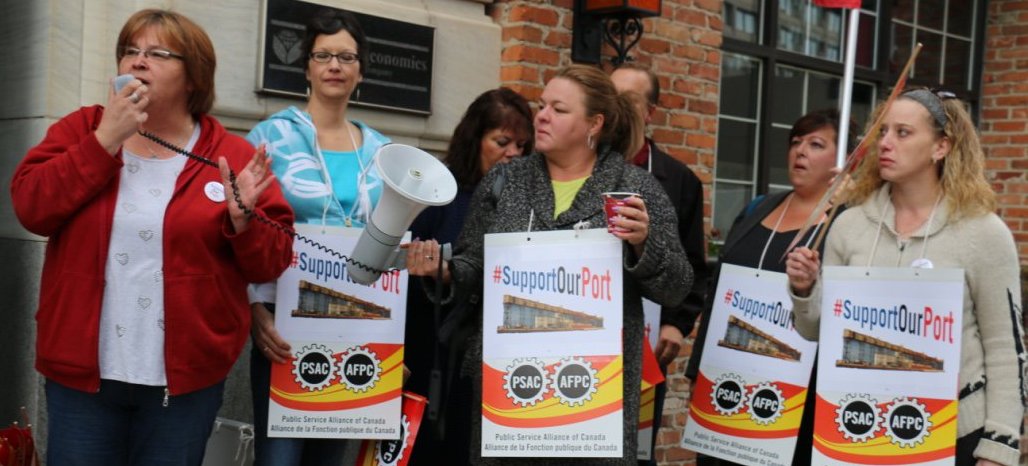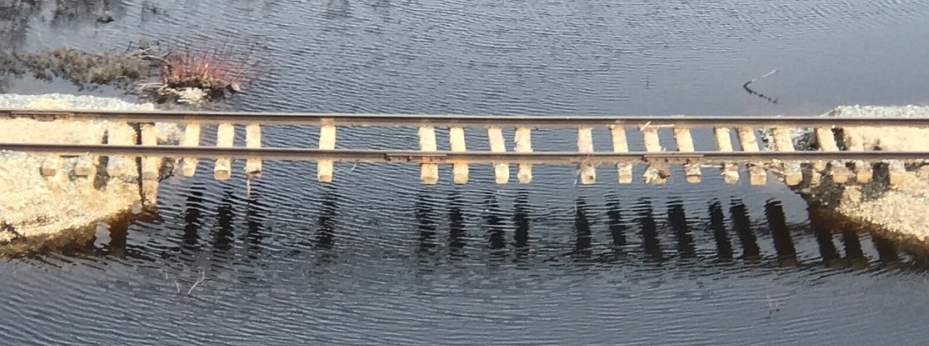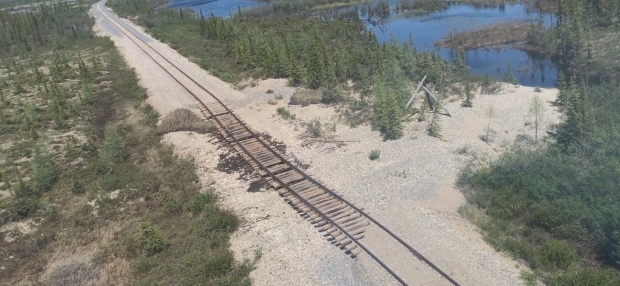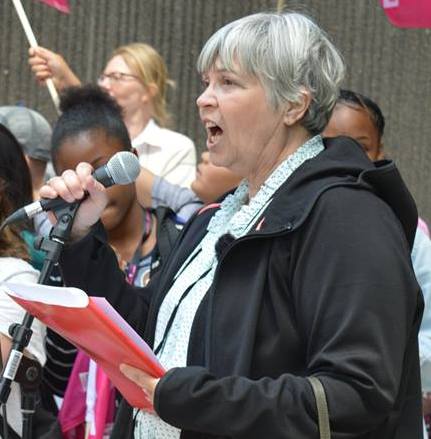|
July 20, 2017
U.S. Owner Omnitrax Refuses to Repair
Railway Line Vital to People in Northern Manitoba
Omnitrax and Governments Must Be
Held Accountable!
PDF
 
U.S. Owner Omnitrax
Refuses to Repair Railway Line Vital to People in
Northern Manitoba
• Omnitrax and Governments Must Be Held
Accountable!
Compensation Is a
Right for All Workers Killed, Injured or Made Sick at Work
• General Electric Workers Demand Compensation
for Years of Exposure to Toxins
Government-Sanctioned
Theft of What Belongs to Workers
and Others by
Right!
• Sears Canada Files for CCAA Bankruptcy
Protection
• Sears Canada's Unilateral Changes to Terms
of Employment
U.S. Owner Omnitrax Refuses to Repair
Railway Line Vital to People in Northern Manitoba
Omnitrax and Governments Must Be
Held Accountable!

Demonstration in Winnipeg, September 21, 2016, against Omnitrax's
closure of Port of
Churchill.
U.S. railway company Omnitrax arrogantly announced its
refusal to
repair the damaged railway line connecting the municipalities of
Gilliam and Churchill for which it is responsible. The line serving the
Port of Churchill is indispensable for the people of Northern
Manitoba.[1]
The railway line deemed the private property of
Omnitrax was
damaged by spring flooding and closed indefinitely on
June 9. The
company also owns the Port of Churchill, which it closed in the summer
of 2016, citing a decline in grain transportation.
Omnitrax held a press conference on July 16, led
by its chief
commercial officer Peter Touesnard. Also in attendance was a railway
expert from the consulting firm AECOM Canada, which had been hired to
assess damages to the rail line and the amount of value and time
required to repair it.
The flooding and damage took place in May and no
repairs, not even
partial, have started. In his technical briefing, the AECOM
representative said repairs would take two months with work beginning
in September. The value needed in work-time and transferred-value would
be anywhere from $20 million to $60
million.

Commenting on the technical briefing, Omnitrax's Peter
Touesnard
declared his private company is a commercial enterprise accountable to
its owners in the U.S. It cannot justify investing any money in
repairs. Touesnard
attempted to portray his ownership group and company executives as
both heroes and victims for having tried but failed to make money from
what he describes as, "an essential service" and "public utility" that
"is not commercially viable."
What the U.S. oligarchs really are saying is that the
pooled
resources of the state should pay the rich to run the rail line both as
an "essential public utility not commercially viable" and as a
"commercially viable private enterprise" using subsidies from the state
or through a public-private-partnership (P3). The state treasury should
guarantee the
highest possible return for the private enterprise and assume all risks
such as damage from heavy spring rains or competition from other
oligarchs that harm the business. In this way, the essential public
utility would be maintained and the oligarchs would pocket a guaranteed
return.[2]

The essential aspect of a public utility such as a rail
line or the
very real necessity of jobs is used to justify P3s and other
pay-the-rich schemes. The people of Northern Manitoba need their rail
line and port, and the U.S. oligarchs have come to be their saviours as
long as the people recognize that Omnitrax is a private enterprise that
needs to
be "commercially viable" and is responsible to render a profit to its
U.S. owners.
The key aspect covered up is that accepting the
oligarchs into the
lives of Canadians deprives the people of the power to determine and
control those affairs that affect their lives such as a rail line, an
essential public utility, bank, local manufacturing or any enterprise
for that matter within the basic sectors of the economy. The oligarchs
become the main block to solving problems, from making the entire
economy viable not just a select part and opening a path forward.
What was the thinking of those in control of Omnitrax
when they
bought the rail line in Northern Manitoba in 1997? They knew at
the
time that the rail line was an essential service, a public utility
serving a small population and port open just half the year at most.
Was it commercially viable at that time and not now or are those just
empty words to justify a self-serving agenda and practice?
The population is small in the north and other
companies were
competing at the time to take freight away from the Port of Churchill
with schemes to wreck the Canadian Wheat Board (CWB). It is the only
land means for the transportation of basic necessities into the north
as well as grain and other products for onward transport through the
port, and for hauling commodities south such as locally cut timber not
to speak of the importance of people simply being able to move around
from town to town in this remote area, in particular to travel to
Churchill for supplies and health care and other services.
The original public utility in control of the line to
Churchill,
the Canadian National Railway (CNR), has long been privatized and has
since
divested itself of the rail line to Churchill by forming the Hudson Bay
Railway Company and selling it in 1997. The oligarchs at Omnitrax
also
knew that as the only land transportation line to the north
they could charge high user fees. Grain farmers in both Manitoba and
Saskatchewan preferred the Port of Churchill for overseas shipping as
it was substantially cheaper than other options and the CWB guaranteed
payment and freight. Besides, as an essential service and public
utility the state would have to intervene if the situation turned sour,
as
it did with the wrecking of the CWB, and now with the damage from the
spring floods.
 Omnitrax determined the rail
line and port were commercially viable
enterprises in 1997. However, the Harper Conservative government
wrecking of the CWB in 2012 drastically reduced
the
transportation of grain by rail to the Port of Churchill, and the
forestry
crisis and closure of the northern mill also negatively
affected the rail line. Against this backdrop of inter-monopoly
competition and fighting, according to Omnitrax, the railway line and
port have lost their "commercial viability," and now finally with the
spring floods and damage have once again become an essential service
and vital public utility "not commercially viable" and in need of a P3
or
state subsidies. Omnitrax determined the rail
line and port were commercially viable
enterprises in 1997. However, the Harper Conservative government
wrecking of the CWB in 2012 drastically reduced
the
transportation of grain by rail to the Port of Churchill, and the
forestry
crisis and closure of the northern mill also negatively
affected the rail line. Against this backdrop of inter-monopoly
competition and fighting, according to Omnitrax, the railway line and
port have lost their "commercial viability," and now finally with the
spring floods and damage have once again become an essential service
and vital public utility "not commercially viable" and in need of a P3
or
state subsidies.
So how do the people in the north, the Indigenous
Nations and
others who have settled there, extricate themselves from this mess,
solve the problems that confront them and build a future for
themselves, which includes holding the rulers to account?
Competing oligarchs have wrecked the CWB against the
wishes of
grain farmers. Oligarchs have closed the northern forestry mill. Their
Port of Churchill has been closed and now their rail line is in a state
of disrepair. The people are deprived of the control, power and
resources they need to deal with the situation.
Usually when oligarchs are faced with a problem such as
Omnitrax,
they demand money from the state, declare bankruptcy of one part of
their empire or shut down and run away. The federal and Manitoba
governments appear to be most concerned with finding a way out for
Omnitrax and allow it to abdicate its responsibilities and not be
held accountable, especially its owners in the United States.
The media report that a spokesperson for Transport
Minister Marc
Garneau issued an email statement following the Omnitrax press briefing
saying:
"Omnitrax has an obligation to repair and maintain its
line and
maintain service to residents, and we expect Omnitrax to meet its
obligations. If Omnitrax fails to meet its obligations, our Government
will have to examine what are the next steps and alternatives to ensure
residents can get the food and supplies they need."

The Manitoba government issued an email statement
through its Minister of Infrastructure saying:
"Today's technical briefing provided by Omnitrax was
clearly
inadequate [and has left] many unanswered and hypothetical questions.
What was made clear today by senior Omnitrax officials is that they are
not prepared to repair, maintain or operate the rail line. It appears
that they intend to abandon the line. If so then it is their obligation
to
the people of Churchill and indeed Manitobans to communicate their
abandonment decision to the federal government."
These mealy-mouthed statements are not acceptable. They
skirt the
main issue of repairing the rail line immediately and holding those in
power and control to account, which includes Omnitrax and both levels
of government. The state privatized the CNR and the Port of Churchill
and destroyed the CWB. Obviously Omnitrax expects state
money or it will simply abandon the rail line and port through
bankruptcy or simply by walking away. The federal and provincial
governments must not hand over any more money to Omnitrax but instead
immediately seize the initiative by taking control of the rail line and
port in cooperation with the Indigenous Nations and others in the
region
and make the necessary repairs.

Omnitrax is one company within the U.S. consortium
called the Broe
Group with headquarters in Denver, Colorado. The consortium has more
than enough resources to make the repairs to its rail line in Northern
Manitoba. Governments have the option to force Omnitrax to do so using
their police powers. The social responsibility for making
the repairs is an aspect of ownership of a public utility. If Omnitrax
refuses and declares local bankruptcy or runs away, governments should
pursue its assets in the United States while at the same time taking
control of the situation by immediately making the necessary repairs
and ensuring the rail line and port serve the economy and people and
not the financial oligarchy and its narrow private interests.
A coalition of Indigenous Nations and various
municipalities in the
region have already presented various options that would make the
railway line and port viable enterprises. Financial reparations from
Omnitrax would become seed money to have the projects see the light of
day. At any rate, a solution to this problem that holds those in the
ruling elite to account and is satisfactory to the people affected must
be found immediately.
Note
1. See "Churchill,
Manitoba
Left
Stranded:
Residents and Neighbouring Communities Demand
Immediate Assistance and Change of Ownership Model for Their Port and
Railway," Workers' Forum, June 19, 2017.
2. All big business now operates either
openly as a P3 or receives subsidies or other state-organized
assistance to make them "commercially viable." Not a week goes by
without an announcement of a pay-the-rich handout to the oligarchs to
make their private enterprises viable whether they are the big banks or
auto or forestry monopolies. The Trudeau Liberal government has even
organized an infrastructure bank as a billion dollar state-organized
anchor to guarantee the private investments of the oligarchs in
infrastructure projects countrywide. All the basic sectors of the
economy are now P3s or some other variation of state-organized
pay-the-rich
schemes. The class privilege of the rich and the domination of their
empires are maintained with the direct assistance of the state and its
treasury and police powers, and by keeping the people deprived of power
to build the new.

Compensation Is a Right for All Workers
Killed, Injured or Made Sick at Work
General Electric Workers Demand Compensation
for Years
of Exposure to Toxins

Over 120 former General Electric workers took part
in a public meeting organized by the Occupational and Environmental
Health Coalition Peterborough (OEHC-P) on July 12. The former
workers at the GE plant in Peterborough Ontario spoke eloquently of
what they and their spouses have endured from years of exposure to
deadly toxins.
The workers were exposed from 1945 to 2000 to
over 3,000 toxins, including 40 that are carcinogens. The
workers were immersed barehanded up to their elbows in chemicals such
as asbestos, arsenic, vinyl chloride, beryllium, formaldehyde,
trichloroethylene, PCBs, uranium, lead, and many others. Workers used
chemical-soaked rags to clean equipment and cut asbestos boards without
proper respiratory equipment. The list of dangerous and abusive
practices is endless.
During those years, General Electric was one of the
main employers in Peterborough. The workforce at the plant reached as
high as 5,000 while today the number has fallen to only 200.
The plant has produced from small to massive electric motors and
generators,
appliances, and small and large electrical components for urban
utilities.
It also had a nuclear facility that produced nuclear fuel bundles for
CANDU nuclear reactors.
|

Sue James speaks at Ontario Injured Workers' Day 2017, as part of a
large contingent of workers from the Peterborough GE plant who
participated in the day's events.
|
The plight of these workers has now been documented in
a detailed report that was published in May by an Advisory Committee
made up of two occupational health and safety researchers assisted by
GE retirees.[1] The report was
sponsored by UNIFOR, which represents 31 of these workers.
The report exposes the conditions the workers endured and reinforces
their demand for automatic compensation for all GE workers who suffered
through these years.
"These GE workers have suffered horrific and often
terminal diseases at a disproportionate rate, yet approximately half of
the compensation claims filed have been rejected, abandoned or
withdrawn due to what was deemed to be insufficient proof," said Joel
Carr, Unifor national representative.
Speakers at the meeting pointed out that over the
past 13 years, GE workers in Peterborough have filed 660
applications for compensation with the Workplace Safety and Insurance
Board (WSIB) but only 280 workers have received any compensation.
Three hundred and forty applications were denied, withdrawn or given
up. Claims were denied
under the hoax that a lack of scientific proof exists linking their
illness to toxic exposure.
Workers reject their unjust treatment with contempt.
Their collective experience of exposure to multiple toxins and
occupational disease including cancers is more than enough proof that
their plight is work-related. They are asking for automatic
compensation for all those who were part of the GE workforce in
Peterborough during those years
and are now suffering illnesses in numbers and severity far greater
than average Canadians. What else could be the cause but their common
exposure to dangerous toxins?
The GE retirees emphasized at the meeting that they are
not satisfied with the words of sympathy from Ontario Labour Minister
Kevin Flynn and the local MPP. They demand deeds, as is their right.
This is especially the case at this time because so many of them are
now old and very sick. They want their dignity as workers upheld, which
requires their claims to be recognized and their suffering compensated.

A victory for the GE retirees would be of great
assistance to all workers who are being denied their right to
compensation and face the silence of the Ontario government and the
WSIB when they make their claims for compensation. According to the
researchers, over 6,000 deaths occur annually in Ontario related
to exposure to toxins
at work. However, the government and WSIB do not relate these deaths
back to their cause at the workplace. The long latency period for many
cancers and other diseases to develop explains in part this problem but
the main obstacle to recognizing the source of the disease, the
researchers explain, is the onerous burden of proof the government and
compensation system unjustly place on workers.
Note
1. The Report of the Advisory Committee on
Retrospective Exposure Profiling of the Production Processes at the
General Electric Production Facility in Peterborough,
Ontario 1945-2000, available here.

Government-Sanctioned Theft of
What Belongs to Workers and Others by Right!
Sears Canada Files for CCAA Bankruptcy Protection
Using the government-sanctioned Companies' Creditors
Arrangement Act (CCAA), the U.S. oligarchs in control of Sears
Canada
have unleashed a broad attack on their active and retired employees.
Seventeen thousand Sears Canada workers, hundreds of laid-off workers
currently receiving severance payments, and 16,000 retirees and
their dependents are under attack from this government-sanctioned theft
of what belongs to them by right.

Using the police powers of the CCAA, Sears Canada
announced without warning on June 22, the immediate firing
of 2,900 workers. The company informed the fired workers
throughout the country that any contractual or legal obligations for
severance pay would not be honoured and that severance pay now going to
previously
fired workers would cease immediately. First to be let go, 300
workers at the Toronto head office of the company were ordered to
appear at locations other than their workplace where they were
summarily fired. Sears representatives told them not to go to their
workplaces, as any personal belongings would be sent to them. Others
will be
fired as stores close.
In a press release on July 6, Sears broadened its
attacks on the working class announcing the cessation of other promised
payments. The measures are contained within a court-enforced CCAA
budget prepared by the CCAA Debtor-In-Possession (DIP). Two secured
creditors of Sears Canada, The Wells Fargo Capital Finance Corporation
and GACP Finance Co. are the administrative agents of the $450
million DIP Financing. Both secured creditors are said to have
significant connections with ESL Investments controlled by the U.S.
billionaire oligarch Edward Lampert. ESL Investments is the principal
owner of both Sears Canada and its U.S. counterpart Sears Holdings
Corp., with thousands of stores in the U.S. known mostly as Sears and
Kmart. ESL Investments seized ownership and control of Sears/Kmart
while it was under U.S. Chapter 11 bankruptcy protection
in 2003. Chapter 11 is similar to Canada's
government-sanctioned CCAA theft of what belongs to workers and others
by
right.
The July 6 Sears Canada press release states,
"Cash constraints at the Sears Canada Group have resulted in challenges
for a number of valued stakeholders, including associates (employees)
whose positions were recently eliminated or will be eliminated when a
number of Sears Canada locations (59) across the country close,
retirees,
suppliers and landlords.
"The Company ... is not able to make payments to
certain stakeholders; payments it would normally make if it were not
cash constrained and operating under the protection of the CCAA.... The
DIP Financing requires that the Sears Canada Group comply with a
budget, which does not provide for the payments listed below.
"Special payments towards the defined benefit component
of the Sears Registered Retirement Plan ... Post-Retirement Health and
Dental Benefits ... (and) Post-Retirement Life Insurance Premiums."
These payments will cease at the end of September.

The Sears Canada annual economic report for 2016
states that the defined-benefit pension plan is underfunded
by $308.6 million in relation to its pension benefit obligations,
its registered pension plans are in a $110.3 million deficit, the
post-retirement health and welfare trust covering promised medical and
dental benefits
and life insurance premiums is underfunded by $196 million, and
the nonregistered supplemental pension plan has a $2.3 million
shortfall.
Sears Holdings Corp. in the U.S. reports a pension
shortfall of U.S.$1.6 billion and millions more in underfunded promises
and social obligations to its U.S. workers and retirees. The company in
the U.S. has not yet filed for another Chapter 11 bankruptcy.
The CCAA government-sanctioned theft not only
negatively affects active workers and retirees but also many others who
hold accounts payable from Sears Canada for contracted work or goods
delivered before June 22. According to CCAA court documents,
payments are suspended to 775 contractors and
approximately 3,300 domestic and international suppliers of
merchandise. This represents a severe blow to those involved and the
economy.
CCAA is a state police measure to victimize the working
class, defend the class privilege of the very rich and serve the narrow
private interests of select oligarchs. CCAA is available only to a
company demanding bankruptcy protection with debts exceeding $5
million. CCAA ensures the assets of a protected company go to secured
creditors at the expense of the working class and others. The recurring
use of CCAA to allow big companies to evade their social obligations to
working people and further damage the economy underscores the necessity
for a new pro-social direction for the economy that recognizes and
upholds the rights of working people and ensures security in
their lives and stability in the economy.

Sears Canada's Unilateral Changes to
Terms of
Employment
Sears Canada is using bankruptcy protection of the Companies' Creditors
Arrangement Act (CCAA) to evade its legally
obligated social responsibilities for employee pensions,
post-employment benefits, and severance pay. Sears Canada retirees have
long worried about this possibility. In a 2013 letter to the
company's chief executive
officer, the Sears Canada Retiree Group representing some of
the 17,000 retirees pointed with concern to the pension plan
deficit of $198.8 million as of January 2012, and a shortfall
of $252.7 million in the health and welfare trust. The
defined-benefit pension plan deficit has since grown to $308.6
million
along with a $110.3 million deficit in the registered pension
plans.

The retirees' letter took issue with the company not
making contributions to the defined benefit portion of the plan for a
period of time and its 2009 announcement to stop funding the
health and welfare trust and instead divert those funds to pay current
wages and for other use. The letter also criticized an extraordinary
cash dividend
paid to shareholders of the company.
Sears Canada workers, similar to most retail workers,
do not have an independent defence organization to fight collectively
for their rights. The company has taken advantage of this lack of
organized collective resistance to worsen employees' terms of
employment. Since the economic crisis of 2008, the company has
dictated negative
changes to the employees' pension plans, post-employment benefits and
other terms of employment.
According to Benefits Canada the Sears Canada
pension plan is now a hybrid defined benefit and defined contribution
arrangement. The company unilaterally discontinued contributions
towards defined benefits in 2008. It also abruptly ended retiree
benefits for all employees not enrolled as of the end of 2008 and
introduced a defined contribution savings plan. The unilateral actions
continued in 2013, when the company further changed the pension
plan to eliminate a benefit for employees who voluntarily resign prior
to the age of retirement. The company has now unleashed a broad attack
using the state police powers of the CCAA.

PREVIOUS
ISSUES | HOME
Website: www.cpcml.ca
Email: office@cpcml.ca
|





 Omnitrax determined the rail
line and port were commercially viable
enterprises in 1997. However, the Harper Conservative government
wrecking of the CWB in 2012 drastically reduced
the
transportation of grain by rail to the Port of Churchill, and the
forestry
crisis and closure of the northern mill also negatively
affected the rail line. Against this backdrop of inter-monopoly
competition and fighting, according to Omnitrax, the railway line and
port have lost their "commercial viability," and now finally with the
spring floods and damage have once again become an essential service
and vital public utility "not commercially viable" and in need of a P3
or
state subsidies.
Omnitrax determined the rail
line and port were commercially viable
enterprises in 1997. However, the Harper Conservative government
wrecking of the CWB in 2012 drastically reduced
the
transportation of grain by rail to the Port of Churchill, and the
forestry
crisis and closure of the northern mill also negatively
affected the rail line. Against this backdrop of inter-monopoly
competition and fighting, according to Omnitrax, the railway line and
port have lost their "commercial viability," and now finally with the
spring floods and damage have once again become an essential service
and vital public utility "not commercially viable" and in need of a P3
or
state subsidies.




